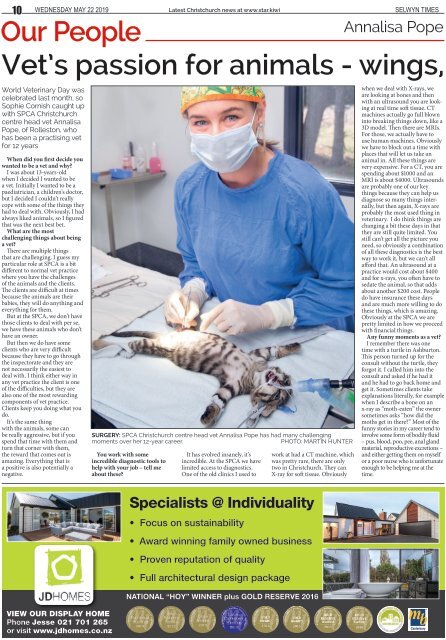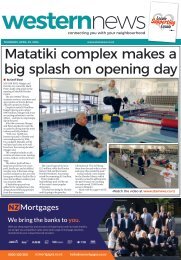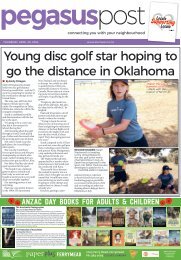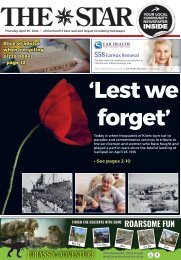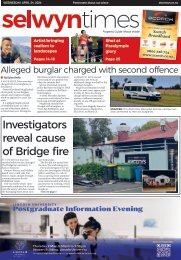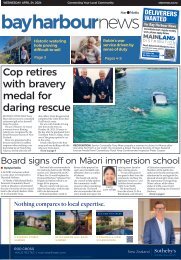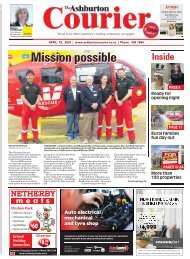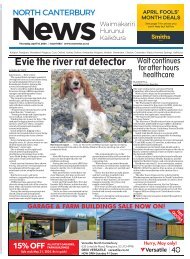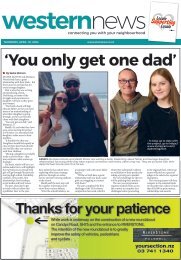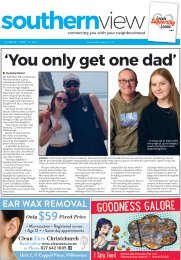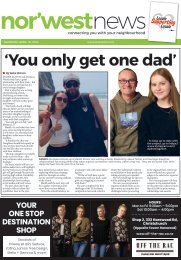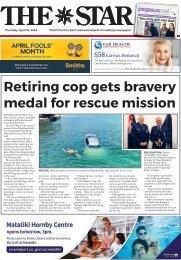Selwyn Times: May 22, 2019
Create successful ePaper yourself
Turn your PDF publications into a flip-book with our unique Google optimized e-Paper software.
10 Wednesday <strong>May</strong> <strong>22</strong> <strong>2019</strong><br />
Latest Christchurch news at www.star.kiwi<br />
Our People<br />
SELWYN TIMES<br />
Annalisa Pope<br />
Vet’s passion for animals - wings,<br />
World Veterinary Day was<br />
celebrated last month, so<br />
Sophie Cornish caught up<br />
with SPCA Christchurch<br />
centre head vet Annalisa<br />
Pope, of Rolleston, who<br />
has been a practising vet<br />
for 12 years<br />
When did you first decide you<br />
wanted to be a vet and why?<br />
I was about 13-years-old<br />
when I decided I wanted to be<br />
a vet. Initially I wanted to be a<br />
paediatrician, a children’s doctor,<br />
but I decided I couldn’t really<br />
cope with some of the things they<br />
had to deal with. Obviously, I had<br />
always liked animals, so I figured<br />
that was the next best bet.<br />
What are the most<br />
challenging things about being<br />
a vet?<br />
There are multiple things<br />
that are challenging. I guess my<br />
particular role at SPCA is a bit<br />
different to normal vet practice<br />
where you have the challenges<br />
of the animals and the clients.<br />
The clients are difficult at times<br />
because the animals are their<br />
babies, they will do anything and<br />
everything for them.<br />
But at the SPCA, we don’t have<br />
those clients to deal with per se,<br />
we have these animals who don’t<br />
have an owner.<br />
But then we do have some<br />
clients who are very difficult<br />
because they have to go through<br />
the inspectorate and they are<br />
not necessarily the easiest to<br />
deal with. I think either way in<br />
any vet practice the client is one<br />
of the difficulties, but they are<br />
also one of the most rewarding<br />
components of vet practice.<br />
Clients keep you doing what you<br />
do.<br />
It’s the same thing<br />
with the animals, some can<br />
be really aggressive, but if you<br />
spend that time with them and<br />
turn that corner with them,<br />
the reward that comes out is<br />
amazing. Everything that is<br />
a positive is also potentially a<br />
negative.<br />
SURGERY: SPCA Christchurch centre head vet Annalisa Pope has had many challenging<br />
moments over her 12-year career.<br />
PHOTO: MARTIN HUNTER<br />
You work with some<br />
incredible diagnostic tools to<br />
help with your job – tell me<br />
about these?<br />
It has evolved insanely, it’s<br />
incredible. At the SPCA we have<br />
limited access to diagnostics.<br />
One of the old clinics I used to<br />
work at had a CT machine, which<br />
was pretty rare, there are only<br />
two in Christchurch. They can<br />
X-ray for soft tissue. Obviously<br />
when we deal with X-rays, we<br />
are looking at bones and then<br />
with an ultrasound you are looking<br />
at real time soft tissue. CT<br />
machines actually go full blown<br />
into breaking things down, like a<br />
3D model. Then there are MRIs.<br />
For those, we actually have to<br />
use human machines. Obviously<br />
we have to block out a time with<br />
places that will let us take an<br />
animal in. All these things are<br />
very expensive. For a CT, you are<br />
spending about $1000 and an<br />
MRI is about $4000. Ultrasounds<br />
are probably one of our key<br />
things because they can help us<br />
diagnose so many things internally,<br />
but then again, X-rays are<br />
probably the most used thing in<br />
veterinary. I do think things are<br />
changing a bit these days in that<br />
they are still quite limited. You<br />
still can’t get all the picture you<br />
need, so obviously a combination<br />
of all these diagnostics is the best<br />
way to work it, but we can’t all<br />
afford that. An ultrasound at a<br />
practice would cost about $400<br />
and for x-rays, you often have to<br />
sedate the animal, so that adds<br />
about another $200 cost. People<br />
do have insurance these days<br />
and are much more willing to do<br />
these things, which is amazing.<br />
Obviously at the SPCA we are<br />
pretty limited in how we proceed<br />
with financial things.<br />
Any funny moments as a vet?<br />
I remember there was one<br />
time with a turtle in Ashburton.<br />
This person turned up for the<br />
consult without the turtle, they<br />
forgot it. I called him into the<br />
consult and asked if he had it<br />
and he had to go back home and<br />
get it. Sometimes clients take<br />
explanations literally, for example<br />
when I describe a bone on an<br />
x-ray as “moth-eaten” the owner<br />
sometimes asks “how did the<br />
moths get in there?” Most of the<br />
funny stories in my career tend to<br />
involve some form of bodily fluid<br />
– pus, blood, poo, pee, anal gland<br />
material, reproductive excretions –<br />
and either getting them on myself<br />
or a poor nurse who is unfortunate<br />
enough to be helping me at the<br />
time.<br />
Specialists @ Individuality<br />
• Focus on sustainability<br />
• Award winning family owned business<br />
• Proven reputation of quality<br />
• Full architectural design package<br />
NATIONAL “HOY” WINNER plus GOLD RESERVE 2016<br />
View our display home<br />
Phone Jesse 021 701 265<br />
or visit www.jdhomes.co.nz<br />
Canterbury


